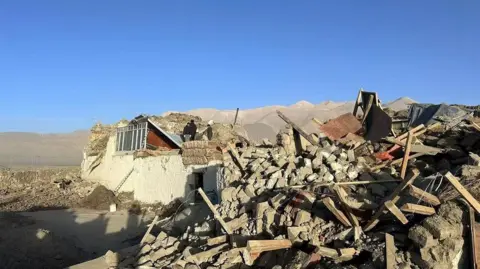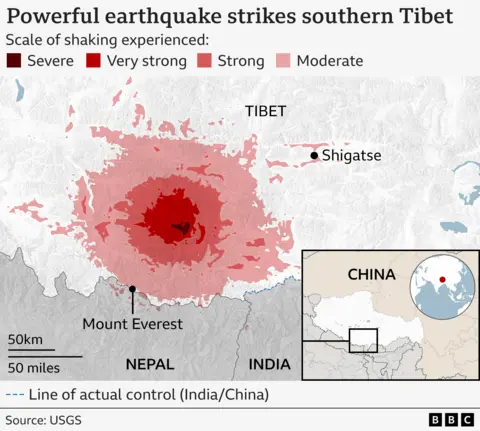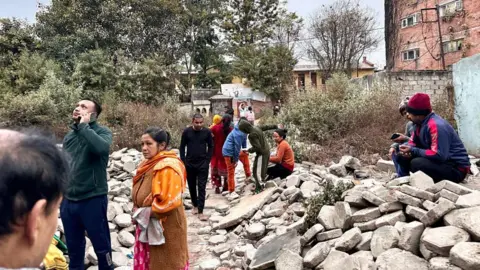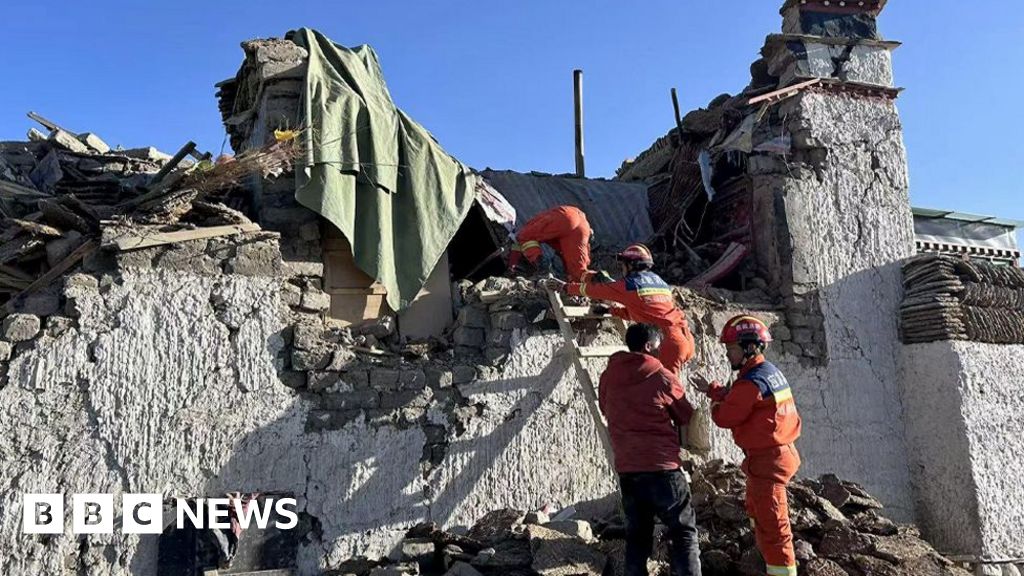 Reuters
ReutersMore than 14,000 rescue workers have arrived in Tibet to continue the search for survivors after a powerful earthquake killed at least 126 people in a remote part of western China.
More than 400 people have been rescued, Chinese state media said, since the earthquake struck on Tuesday, about 50 miles from the base of Mount Everest, destroying thousands of homes.
Vice Premier Zhang Guoqing arrived on Wednesday to oversee the operation, which is being hampered by winter temperatures that fell to -16C overnight.
Earthquakes are common in the region, which sits on a major geological fault line, but Tuesday’s was one of China’s deadliest in recent years.

The 7.1-magnitude quake, which struck at a depth of 10 km (six miles), according to data from the US Geological Survey, was also felt in Nepal and parts of India, which neighbors Tibet.
Internet access is limited in Tibet, which is tightly controlled by Beijing, and journalists cannot travel there without government permission. So much of what we know about the earthquake and its aftermath is from Chinese state media.
The air force has been deployed and drones sent to help rescuers as President Xi Jinping called for a comprehensive effort to minimize casualties and resettle affected residents.
The state-owned People’s Daily says more than 30,000 people have been relocated to the region. Electricity and cellphone service in Tingri county, near the epicenter, was restored Wednesday morning, according to state media.
Officials estimated that more than 3,600 buildings had collapsed, potentially leaving thousands without shelter.
Videos released by China’s state broadcaster CCTV showed houses destroyed and buildings toppled in Tibet’s holy city of Shigatse, with rescue workers wading through debris and handing out thick blankets to locals.
Sangji Dangzhi – whose supermarket was damaged in the earthquake – told the AFP news agency by telephone that the destruction of homes had been extensive.
“Here the houses are made of dirt, so when the earthquake came… lots of houses collapsed,” the 34-year-old said, adding that ambulances had been taking people to hospital throughout the day.
A hotel resident in Shigatse told Chinese media Fengmian News that he had been jolted awake by a wave of tremors. He said he had grabbed his socks and rushed out into the street, where he saw helicopters circling overhead.
“It felt like even the bed was lifted,” he said, adding that he immediately knew it was an earthquake because Tibet had recently experienced several smaller earthquakes.
There were more than 40 aftershocks in the first few hours after the earthquake.
Jiang Haikun, a researcher at the China Earthquake Networks Center, told CCTV that although another magnitude 5 earthquake could occur, “the probability of a major earthquake is low”.
Located at the foot of Mount Everest, which separates Nepal and China, Tingri County is a popular base for climbers preparing to scale the world’s highest peak.
Everest sightseeing tours in the area have been cancelled, a tourism official told local media, adding that the area had been closed. There were three visitors, all of whom had been moved to an outdoor area for safety, they said.
The Shigatse region, home to 800,000 people, is the traditional seat of the Panchen Lama, a key figure in Tibetan Buddhism whose spiritual authority is second only to the Dalai Lama.
The Tibetan Gedhun Choekyi Niyima, who was identified as the reincarnated Panchen Lama was disappeared by China in 1995 when he was six years old. China then elected its own Panchen Lama.
“I offer my prayers for those who have lost their lives and extend my wishes for a speedy recovery to all who have been injured,” the current Dalai Lama said in a statement.
He fled Tibet for India in 1959 after China annexed the region, and has since been seen as an alternative source of power for Tibetans who resent Beijing’s control — which extends to local media and Internet access.
 Getty Images
Getty ImagesWhile strong tremors were felt in Nepal, no major damage or injuries were reported, a National Emergency Operations Center official told BBC Newsday – only “minor damage and cracks in houses”.
The tremors on Tuesday morning, which sent many Kathmandu residents running from their homes, brought back memories of the deadly 2015 earthquake. The 7.8-magnitude quake struck near Kathmandu, Nepal’s capital, killing nearly 9,000 people and injuring more than 20,000.
“In 2015, when the earthquake hit, I couldn’t even move,” Manju Neupane, a shopkeeper in Kathmandu, told BBC Nepali. “Today the situation wasn’t that scary. But I’m afraid another big earthquake might hit us and we’ll be trapped between tall buildings.”

